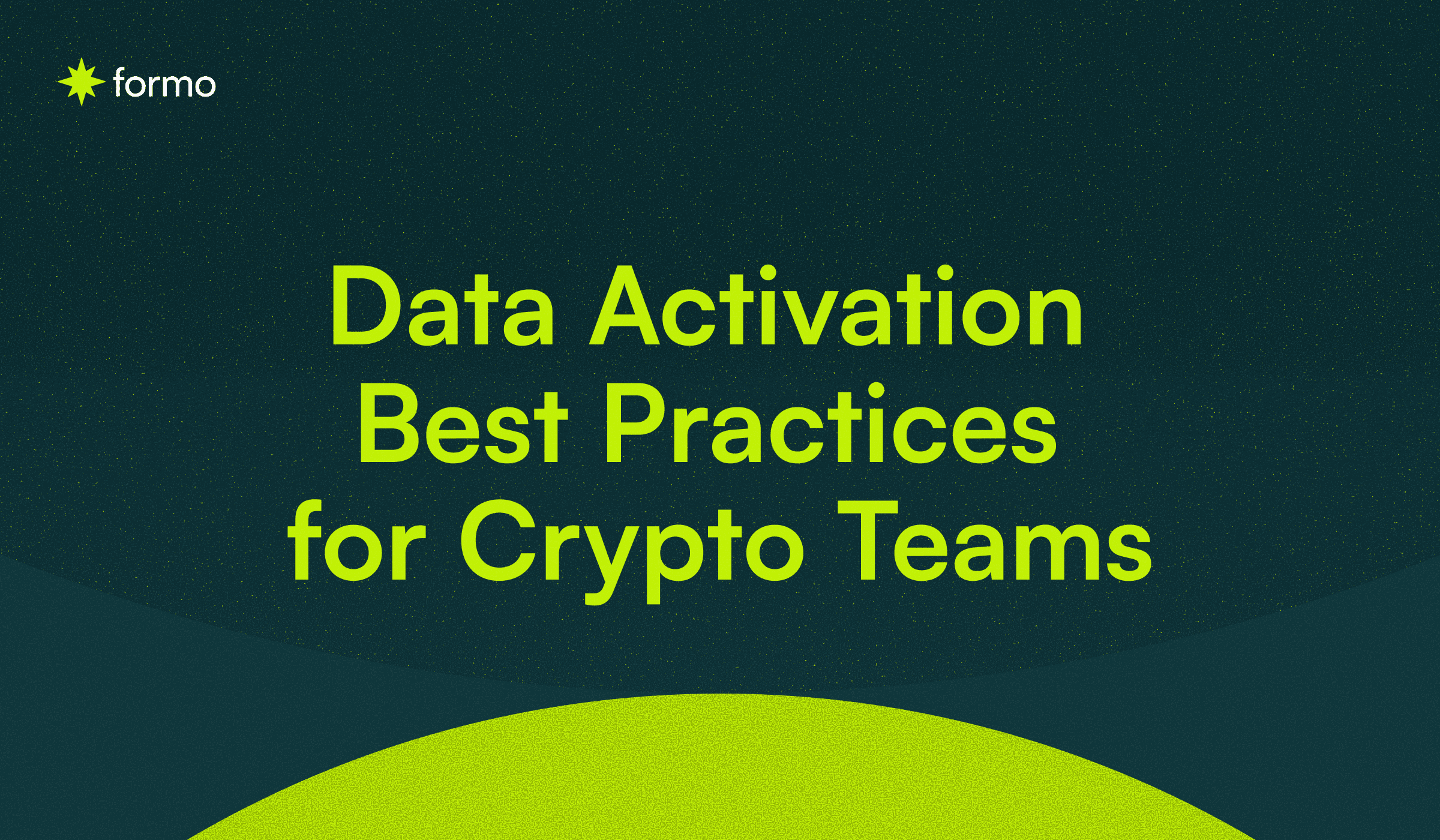Do web3 incentives drive long-term growth or just attract fleeting capital? In the competitive landscape of decentralized finance (DeFi), protocols constantly seek ways to attract users and liquidity. Incentive programs, often involving large token distributions, have become a go-to strategy for web3 user acquisition. But measuring the true return on investment of these campaigns is a significant challenge for web3 marketing teams.
This post dissects the impact of a large-scale incentive program using onchain data analytics, using Compound's 1.8 million ARB token grant as a case study based on research by Castle Labs.
We will explore user retention, the difference between new and reactivated users, and what onchain growth analytics reveal about user behavior. By the end, you will gain a clear framework and actionable insights for designing and measuring your own web3 retention strategies.
Understanding Web3 Incentive Programs
At their core, web3 incentive programs reward users for performing specific onchain actions. These actions can range from providing liquidity and staking tokens to trading, borrowing, or participating in governance. The rewards themselves come in various forms, including native tokens, points, or exclusive benefits.
The goal is to stimulate network activity and bootstrap growth. However, the history of web3 is filled with examples of airdrops and reward campaigns that led to a surge in activity followed by a sharp decline once the incentives dried up. This has pushed the industry to evolve from simple airdrops to more sophisticated, data-driven loyalty and retention programs.
Platforms like Merkl.xyz, Boost.xyz, and Turtle.xyz have emerged to help protocols design and manage incentive campaigns more effectively.
Merkl allows protocols to create customized incentive programs to boost liquidity and user engagement, having distributed over $200M in incentives. They support various campaign types, including liquidity incentives, airdrops, and point systems across more than 50 chains.
Boost is a marketplace for onchain actions, enabling any wallet to deploy incentive offers for other wallets to perform specific onchain tasks. It provides a flexible protocol that supports dynamic rewards and universal contract integration.
Turtle functions as a liquidity distribution protocol, helping projects promote incentive programs to a large network of active liquidity providers and structure ecosystem-wide rewards to foster sustainable TVL growth.
While these platforms provide the infrastructure to execute growth campaigns, measuring their true effectiveness requires a robust web3 analytics framework. Let's examine Compound's program to see how this works in practice.
A Look at Compound's Incentive Program
To analyze the effectiveness of web3 incentives, we examined Compound's largest grant ever: 1.8 million ARB tokens awarded by the Arbitrum DAO. This program was designed to boost liquidity and user engagement on the protocol.
Distribution Partners: Compound partnered with platforms like OKX, VaultCraft, Merkl, and Layer3 to maximize the reach of the token distribution.
Key Metrics: While initial success was often measured by Total Value Locked (TVL) and deposit volumes, a deeper analysis required looking at web3 retention and user behavior metrics.
Analysis Phases: We broke down the analysis into three distinct periods: pre-incentive, during the incentive program, and post-incentive. This allowed us to isolate the program's direct impact.
Onchain Attribution: A critical component of this web3 data analytics effort was onchain attribution. By tracking the origin of wallets, we could differentiate between organic activity and behavior directly driven by the incentives.
Challenges of Web3 Incentive Programs
Launching an incentive campaign in web3 is easy—driving real, lasting growth is hard. Protocols often face several key challenges:
Short-Term Activity Spikes: Incentive programs can quickly inflate metrics like TVL and user count. But without true user commitment, this growth often fades as soon as rewards end.
Mercenary Capital: Many users chase the highest yields and move funds rapidly between protocols. This "mercenary capital" inflates numbers temporarily but rarely converts into loyal community members.
Retention Hurdles: Achieving sustained engagement is tough. Incentives may bring in new users, but keeping them active after the campaign demands deeper value, product-market fit, or strong network effects.
Measurement Complexity: Separating organic growth from incentive-driven activity is complex. Without detailed attribution and behavioral analytics, teams risk optimizing for vanity metrics, not real outcomes.
Understanding these obstacles is critical to designing campaigns that move beyond surface-level metrics and deliver meaningful long-term impact.
The TVL Surge: New vs. Returning Users
Compound’s incentive campaign produced a dramatic impact on protocol metrics, but the underlying drivers were not what most would expect.
180% Growth in TVL: During the incentive period, Compound’s TVL grew from $90M to $260M. This surge was not evenly distributed across user types.
Returning Users Led Deposits: Reactivated users—wallets that previously interacted with Compound but had gone dormant—were responsible for 4.5 times more deposit volume than brand-new users. Campaigns that re-engage former participants can often generate outsized results with relatively lower acquisition costs.
Asset Performance Split: Incentivized assets like USDC and USDT each saw inflows in the $30M+ range, while non-incentivized pools barely moved. The data here is clear: incentives work best when aligned with user preferences and liquidity needs.
These findings point to the value of supporting core stablecoin pools and tailoring campaigns to boost the activity of users already familiar with the platform.
Cohort Retention Analysis: The Six-Month Cliff
Retention is what separates short-term spikes from sustainable, onchain growth. Key findings on retention:
Deposit Patterns by Cohort: By tracking deposit volumes by user cohort—grouped by the period in which they entered—the analysis uncovered a key inflection point. Users who joined during incentive periods started with higher deposits but retained at a much lower rate over six months than those who joined organically.
7% vs. 12.8% Retention: Incentivized cohorts posted a 7% retention rate at month six, while pre-incentive groups retained nearly double that, at 12.8%.
Normalization Matters: It’s easy to be misled by headline numbers. Only deep cohort analysis reveals that large, incentive-driven inflows can inflate short-term metrics while masking long-term drop-off.
Retention-focused analytics empowers teams to experiment, iterate, and ultimately structure incentive programs that build a durable user base—not just headline growth.
High-Value User Profiles: The Retention Winners
Not all users contribute equally to protocol growth. Analyzing retained versus inactive cohorts reveals insights you can use for smarter, more cost-effective campaigns:
Retained users drive value. On Compound, retained users deposited an average of $154,000—far higher than the $9,000 average from inactive users. Prioritizing these high-value users can meaningfully impact protocol revenue.
Strategic behavior. Retained users made fewer but larger transactions. This pattern suggests they’re more purposeful with their liquidity, often sticking around for protocol utility versus just chasing one-time rewards.
USDT stands out. Stablecoin preferences matter—30% of retained user deposits were in USDT, pointing to patterns for targeting future incentive pools.
Sybil resistance. Fewer, larger transactions act as a filter. Campaigns that reward substantial activity over volume can help exclude reward farmers using bots or multiple wallets.
Identify, engage, and reward high-value users—they’re the foundation of sustainable, onchain growth.
8 Key Findings That Reshape Web3 Growth Strategy
Incentives Reactivate Dormant Capital. Returning users drove the most growth, highlighting how re-engagement can outperform pure new user acquisition.
High-Capital Users Create Outsized Impact. Targeting “whale” users early ranks among the most efficient paths to protocol growth.
Distribution Channel Quality Trumps Quantity. Not all partners deliver the same value—onchain attribution is essential for finding your best sources.
Stablecoin Pools Drive Retention. USDT/USDC pools outperform volatile assets in keeping users engaged over time.
Expect a Six-Month User Cliff. Across DeFi, many users go inactive after six months; plan re-engagement around this lifecycle.
Utilization Outranks Supply for Health. TVL by itself is a vanity metric unless liquidity is also put to work—protocols need both.
Macro Factors Matter. Broad market swings can confound attribution, so cohort-based approaches cut through noise.
Behavioral Analytics Beat Vanity Metrics. TVL and wallet count only go so far. Retention and revenue tracks the real story.
Why Long-Term Tracking Matters for Revenue and Retention
Too many teams focus on short-term spikes post-campaign, only to discover months later that revenue and usage have collapsed. For any DeFi or web3 protocol, tracking long-term effects of incentive programs is mission-critical.
Key takeaways:
Vanity Metrics ≠ Real Growth. TVL runs up during a campaign, but how much of that liquidity stays? How many wallets remain active?
Revenue Tells the Story. Real revenue comes from retained users who borrow, trade, and participate long-term—not those optimizing for the biggest promo.
Retention Sets the Baseline. Cohort analysis shows which campaigns actually drive “sticky” user growth.
Data-Informed Budgeting. By understanding how incentives translate (or don’t translate) into future revenue, teams can optimize spend and design smarter campaigns.
How Robust Analytics Enables Sustainable Growth
Getting long-term growth right depends on having a robust analytics stack:
Comprehensive Attribution: Cohort- and channel-based attribution lets you pinpoint which partners, campaigns, or products bring the most valuable users. Measure meaningful actions and conversions instead of just clicks and visits.
Cohort Dashboards: Track retention, TVL, and revenue by user group over 3-, 6-, and 12-month windows.
Automation & Alerts: Real-time diagnostics detect drops in activity or sudden reversals, so you can iterate quickly—instead of months later.
Infrastructure Matters: Platforms like Formo integrate onchain, offchain, and wallet-level data. For teams without dedicated data analysts and engineers, such tools simplify cohort tracking, attribution, and optimization.
How to get started:
Install a crypto-native analytics tool to start capturing activity and conversion data on your website and app.
Review key dashboards to measure user activity by source and by time.
Use cohort analysis to identify long-term contributors.
Refine campaigns based on which incentive structures and distribution partners actually deliver sustainable revenue.
Implementing Retention-First Incentive Design
Designing around retention isn’t just best practice—it’s a necessity if you want to build for the long haul.
Define User-Level Success: Know what actions matter for your protocol (e.g., repeat deposits, protocol utilization, governance participation) and make these behaviors the goal of your campaign.
Tailored Incentives: Segment user groups and deliver differentiated offers to whales, reactivated users, or first-timers. This approach stretches your incentive budget and boosts efficiency.
Channel Optimization: Attribute results by partner. Double down on channels that deliver strong retention. Cut or rethink those that don’t.
Continuous Analytics Integration: Track and iterate in real-time, not just after the fact. Make “retention over time” your north star metric.
The Analytics Infrastructure Behind Growth
The best growth teams build with granular, actionable analytics—not aggregated vanity numbers. Your web3 analytics infrastructure should:
Unify offchain marketing spends and onchain user activity in one view
Enable wallet-level segmentation, tracking, and behavioral cohort-based analytics
Provide real-time, drill-down dashboards and alerting
Support cross-chain and cross-partner reporting
This unlocks smarter product decisions, evidence-based growth campaign optimization, and a true understanding of what drives sustainable protocol growth. Get started today.
The Future of Web3 Growth
The era of simply airdropping tokens to attract users is over. Future web3 incentives will be rooted in granular data, targeting meaningful behavior and real onchain impact over clicks and simple wallet counts.
Standardize Evaluation: Make cohort analysis and partner attribution core to every campaign.
Use Live Dashboards: Don’t wait for a post-mortem—monitor campaign health as it unfolds.
Promote Industry Standards: Advocate for onchain transparency and best practices around retention analytics so the entire ecosystem can build better.
Smart incentives plus robust analytics equals compounding protocol growth.
Follow Formo on LinkedIn and Twitter, and join our community to learn more onchain growth insights!
Frequently Asked Questions
How do you differentiate between organic growth and incentive-driven growth in web3?
Onchain attribution allows you to trace wallet origins and user journeys. Tag wallets by campaign or partner source, then compare those cohorts' activity and retention to fully organic users.
What metrics should protocols track during incentive programs beyond TVL?
Retention rates, cohort-based deposit and activity volumes, user lifetime value (LTV), asset utilization, and average transactions per user yield deeper insights than aggregate TVL.
How can smaller protocols implement similar retention analysis without dedicated data teams?
Use no-code analytics platforms like Formo, which provide dashboards for cohort retention, onchain attribution, and partner/source segmentation without heavy technical lift.
What's the optimal duration for web3 incentive programs based on user behavior patterns?
Six-month data shows that many users drop off after incentives end. Structure programs to include cycles of re-engagement and analyze each phase for continuous optimization.
How do you prevent Sybil attacks while running large-scale incentive programs?
Reward meaningful actions (e.g., high-value deposits, protocol utilization), not just sign-ups. Monitor wallet clustering and transactional behavior to flag suspicious patterns automatically.
What role do distribution partners play in long-term user retention and campaign effectiveness?
Distribution partners are a critical filter for user quality. The right partners can deliver high-value, engaged users who stick around after incentives end, while the wrong ones may just drive short-term mercenary capital. Use onchain attribution to measure each partner’s contribution to sustained retention and protocol growth.
How can protocols identify and target high-value, long-term users during incentive campaigns?
Analyze onchain behaviors such as deposit size, transaction frequency, and preferred assets. High-value retained users often contribute much larger deposits and transact less frequently but with more intentionality. Design tailored rewards and segmented messaging to engage this group—these users drive outsized protocol revenue and stability.
What analytics infrastructure is needed to measure long-term impacts of incentive campaigns?
You need platforms that unify onchain and offchain data, support cohort-based retention and revenue tracking, and offer real-time dashboards for partner and campaign attribution. Without this, it’s nearly impossible to separate short-term spikes from lasting, sustainable growth. Prioritize tools that make deep behavioral analysis accessible and transparent for your whole team.
Why are behavioral analytics more valuable than vanity metrics for web3 protocols?
Vanity metrics like TVL and raw user counts can be inflated by short-term campaigns and mercenary capital, masking true user engagement and program sustainability. Behavioral analytics—tracking retention, re-engagement, and value per user—offer a precise measurement of which activities drive lasting growth and revenue.
How do you use cohort analysis to improve future incentive programs?
Cohort analysis lets you segment users by when they joined or how they entered the protocol, then track their behavior over time. This reveals which campaigns and entry points generated the most engaged, valuable users. With these insights, you can refine targeting, optimize channel mix, and design incentives that encourage genuine loyalty versus short-lived participation.
What practices help protocols shift from emissions-heavy to retention-first incentive strategies?
Start by defining clear user profiles and success metrics before launching campaigns. Track user segments in real time, integrating cohort and attribution reporting so you can adjust tactics as the campaign progresses. Offer rewards that go beyond simple deposits—such as governance participation or deeper protocol utilization—to incentivize actions linked with long-term value. Above all, focus on continuous data feedback and experimentation to fine-tune your approach for sustainable growth.
How do macro market conditions influence the outcomes of web3 incentive programs?
Broader crypto market movements can magnify or obscure the impact of incentive campaigns. During bullish periods, user and liquidity growth may be inflated by overall sentiment rather than program effectiveness. Using cohort analysis and comparing against market benchmarks helps untangle true program results from external conditions, so protocols can adjust strategy in real time.
What’s the best way to balance supply- and demand-side incentives in DeFi protocols?
A healthy protocol balances incentives for both liquidity suppliers and borrowers/users. Focusing too much on inflows (supply-side) can inflate TVL without improving real activity or retention. Demand-side incentives—such as reduced borrowing rates or new utility features—drive protocol usage and make liquidity stickier. Measuring usage metrics and user feedback ensures both sides of the ecosystem grow together.





